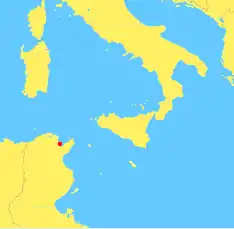
Carthage was a small nation, first only it was a city state , founded in 814 BC. It grew prosperous by all the trade that flowed through the tiny nation. However at around 146 BC, Carthage was conquered by Rome.
What country did they live in?
Carthage was located in northern Africa, in current day Tunisia. It was an imperial power that controlled at one point most of northern Africa and even had some colonies in preset day Spain. However they often fought with Rome for land in Sicily and Sardinia, islands near Italy. These fights were also known as the Punic Wars. Carthage was a country full of seafaring people, and they established settlements in western Africa and in the Mediterranean Sea, their fleet being the largest in the west Mediterranean.
What did their buildings look like?
The buildings in Carthage are similar to buildings in Greece and Rome. Major public buildings were made of stone and had large columns. Meanwhile common people lived in small houses made of brick or wood. We do not have Carthaginian buildings standing today because the Romans destroyed the city. We can guess at what they might have looked like by comparing Greek and Roman examples.
What did they eat?
People of Carthage ate food similar to that of the people there today, like dates, figs, bread, and meat from sheep and cows.
What did they wear?
For woman the chiton is a common sleeved tunic. It is two pieces of cloth which are sewn together, leaving room for the arms and head. Married woman wore a stola, which was a long, sleeveless tunic, which would be worn over the chiton. When going outdoors a palla could be worn over these garments. Woman of the upper class wore jewellery.
What did their writing look like?
The Phoenicians adopted an early Canaanite linear script in the Middle Bronze Age (2000-1500 BC). Over the centuries this evolved into numerous other scripts such as Hebrew, Aramaic, Arabic and Greek. The Phoenician language evolved from the local dialects of the cities of Tyre and Sidon. The colonization of the Mediterranean spread the language as far West as North Africa and Southern Spain where it became known as Punic. This was adopted as the official language of the Carthaginian Empire.
What did they believe?
They believed in a pantheon of gods, that included Baal Hammon, Astarte, Eshmun, and many more.
What is their history?
Carthage was founded around 800 BC at what is now Tunisia. It was originally a part of the Phoenician Empire, which was based in Lebanon. When the empire was invaded, Carthage remained safe and became a powerful nation of its own. The skills of sailing and exploration that they had got from their Phoenician relatives helped them to trade and expand their lands. They settled in Sicily, Sardinia, Corsica, Spain and Portugal. Carthage was one of the major powers of the Mediterranean Sea.
During the 5th and 4th Centuries BC they fought against the Greeks for control of Sicily and its trade. In the 3rd Century BC they started fighting with Rome, which was getting powerful as well.
The First Punic War was fought between Carthage and Rome to decide who would control Sicily. It took place from 264 - 261 BC. The Romans were not great sailors, but somehow, they beat the Carthaginians three times in a sea battle. In 261 BC the Carthaginians Surrendered. They lost Sicily, along with Sardinia and Corsica.
The Second Punic War was fought between 218 - 201 BC. This was the war that the great general Hannibal was famed for - he nearly defeated Rome. Hannibal marched from Spain to get to Italy over the Alps with his elephants. He defeated many Roman armies, but he could not take Rome itself. Eventually the Romans attacked Spain and Carthage itself to distract Hannibal. Hannibal was ordered to come back to Carthage to help against the Romans at the Battle of Zama. Hannibal was defeated and the battle ended up as a Roman victory. Carthage had to pay a lot of money to Rome and promise to recognise Rome as the greatest power. It also lost its empire in Spain and Portugal and its army was made very small.
The Third Punic War was fought in 150 BC. Carthage had recovered and attacked Numidia - a Roman land. This time, Rome invaded Carthage and totally destroyed the city so that it would never cause trouble again.
Are some of them famous even today?
Hannibal is by far the most famous Carthaginian. He led an almost successful invasion on Rome, attacking them in Spain and Northern Italy, but eventually failed. Hannibal is often connected with elephants because he used elephants against Roman Troops, however most died while crossing the Alps on the way to Rome.
A famous Carthaginian from Roman mythology is Queen Dido. In the myth, she was the ruler of Carthage when Aeneas, a Trojan who had escaped from the Greek attack on Troy, landed in her kingdom. She loved Aeneas, but he needed to find Italy where he would found the empire of the future Romans. Dido killed herself when Aeneas left Carthage.
What is left of them today?
Being the bitter enemies of the Romans, having fought over Mediterranean power and over islands like Sicily for many decades, the Roman Empire sought to totally destroyed Carthage so as to eliminate its threat altogether. Carthaginian civilization therefore ended with its conquest by Rome in the Third Punic War, where it was eventually destroyed.
It is a common misconception that Rome sowed Carthage with salt after this final war. This is, however, a mere exaggeration showing their deep hatred; Appian, a Greek historian, tells us that the Romans colonised Carthage afterward. Emperor Augustus rebuilt it close to its original site 102 years after its destruction, and it became part of the Roman Empire.
Its archaeological site now lies in Tunis, the capital of Tunisia, in Africa.